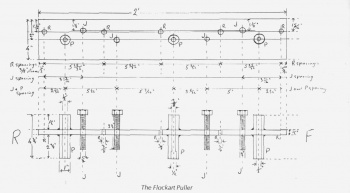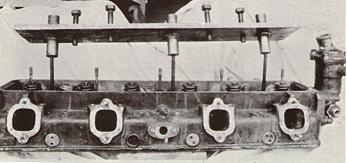From RROCA-info
PIG-HEADED
by John Flockart, 1980
Generally speaking one would not use the term pigheaded in association with any Rolls-Royce car. But upon reflection one realises that history reveals the master himself, Sir Henry Royce, could, on occasion, be decidedly this way. As this seems often a spin-off from a character of drive and determination, not perhaps so surprising. However, though most great cars carry the stamp of their designer's character, one would not expect this particular facet to appear, but it does, alas, in one aspect of the post World War II six-cylinder cars. Since becoming a Club member I have read on a number of occasions of the problems besetting owners of post-war cars afflicted with seized-on cylinder heads.
In starting the overhaul of my 'R' Type I found I too had a cylinder head which would not budge. Once it was apparent the head was not going to free just by asking nicely, I decided two things. First, that if it was going to be a matter of pigheadedness, then I would persist longer than the Bentley. Second, that the head must come off undamaged, patience and avoidance of any rash action. Since I always seem to have more things I want to do than spare time in which to do them, anything non-productive tends to be ignored, so after each abortive attempt the job was left to look after itself (well soaked in easing oil), whilst I thought about it and attended to other matters. Thus when the head eventually came off nearly twelve months had elapsed since the start was made on dismantling.
Amongst other things, I came upon the suggestion of using vinegar or glacial acetic acid poured round the studs which should gradually work down the stud holes and dissolve the corrosive products. Two things mitigated against the idea. The first was that on an earlier occasion when replacing a badly fitted gasket which had blown early on in its life, I liberally greased all the head studs hoping this would ensure easy removal in the future, and secondly, I optimistically tried to make the initial lift by using the engine compression, which blew oil freely up around a number of stud holes. As the vinegar or acetic acid will not act in the presence of oil this seemed a forlorn hope, but I tried it nevertheless. Then I recalled reading in the R.R.E.C. Bulletin a suggestion for overcoming a similar problem with a Phantom III engine. This involved taking a piece of mild steel tubing that will slide easily over the stud, and turning it to a wall thickness that will let the resulting thin tube fit between the stud and its hole. This tool I made up filing two large serrations to act as cutters on the business end. Mounting this in a hand brace and using plenty of easing oil I spent many hours gradually working the tube down round the studs. It was a slow process, virtually scrape and soak, scrape and soak. Ultimately I managed to get the cutter tube almost to the gasket on most of the short studs and within � to � an inch on the longer ones. There I was stuck as the cutter tube being about the same thickness as tin plate had really very little strength to it. To get this far I made up a number of cutter tubes as they gradually broke up in use. The moments when the tube jammed when well down the stud hole were most traumatic, but fortunately retrievable.
For the final solution to my problem I am, and always will be, greatly indebted to Rolls Royce Motors at Crewe. I wrote more in hope than expectation, and received the most courteous and helpful reply. The writer, Mr. I. Fletcher, commented that in their experience the most stubborn head would free by repeated tightening down and then releasing of the holding down nuts, combined with plenty of easing oil, an idea I had not heard of, then went on to suggest, since I appeared to have been persisting with my problem for a long time already, that I use a puller for which he enclosed a diagram. Since the dimensions were marked as approximate only I marked out the plan on a piece of sheet steel, cut it out, and tried it on the head. I found a number of the hole spacings needed alteration, but having done this and obtained a pattern, it was then possible to go ahead and successfully make up the puIler.
The diagram I have enclosed (R-Type Head Puller) gives the dimensions which will fit the R. Type head perfectly, but not the Mark VI. I imagine the design as originally sent to me was for a tool that could be used on a number of very similar engines. From the sketch and photographs together the layout should be clear. Basically the puller consists of a piece of � inch mild steel 4 inches wide and 2 feet long. Into it are welded three 1 inch diameter rods 4 3/8 inches long with holes drilled through the centres. These short tubes fit over the rocker cover holding down studs, and I started with all three holes 3/8 inch diameter believing this should give ample clearance over the 5/16 inch studs. However on trying the puller this was unsatisfactory as due to either the steel plate not being quite straight, the welded rods not quite true, or the drill having wandered, the tubes just would not more than start to slide over the studs. Thus I drilled out the two end tubes � inch, and also counter bored the lower end of the centre tube � inch, as I realised this would be needed to clear the base of the studs which are 7/16 inch diameter. In my sketch the row of 5 holes marked R represent clearance holes to allow the plate to pass over the rocker pedestal studs. These holes are 3/8 inch diameter. The 4 holes marked 1 are drilled to take a � inch tap, in this case Whitworth, but any thread type would suffice. The jackscrews are � inch diameter, 3� inches long and threaded along their full length. The original sketch I worked from showed these screws carrying 1 inch diameter caps screwed over the lower ends, but I did not bother with these, and indeed the � inch jackscrews I found centred very satisfactorily over the 3/8 inch diameter cylinder head studs.
The tool worked most successfully, in fact the four jacking screws required very little tension applied from the 12 inch shifting spanner I used on the screw heads. By this time, of course, the studs had been well soaked in easing oil and largely cleared out in their holes so the work of the puller was reduced to the minimum. Having made use of the tool I feel bound to comment that one of its greatest virtues is the way it lifts evenly from around the centre of the head. Once the initial lift had been made I noticed how easy it was in wriggling the head upwards to have it bind on the studs when it became unlevel. Present day labour costs being what they are the tool was costly for what it represents sitting on the shelf. However if considered in relation to the cost of a replacement head with all the fuss and bother that can involve, or as part of the full overhaul costs, then it is a very cheap item. With your own welding gear, the material cost is small, and the time and money spent would be marginal related to its usefulness. I hope others who may be confronted with a difficult head can make use of this gadget as successfully as I have. The only doubt I have is that if the head is really tight, it would be wise then, before getting too energetic with a spanner on the jackscrews, to remember that the lift is being taken through the rocker cover studs which were not designed for lifting purposes.
(Note: A similar puller has been used for PIII heads. This was designed to lift from the edge of the block - a similar approach could be the next step to the above. Ordinary grease over the studs will not usually prevent erosion but gapfile grease will. - Bill Coburn)



